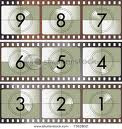Halloween holds no sway here in Australia – no trick-or-treating, no scary films on TV (although the local reality talent(less) show X-Factor is on tonight, that's pretty horrifying). Nevertheless, I thought I'd weigh in with a brief list of - oh yeah, you smarty, you guessed it! - horror films.
This isn't a 'top ten of all-time' thing, or even a list of best scariest scenes. I thought I'd just offer a handle of moments from horror films that are just a little sublime. The scenes are not necessarily chosen because they offer the best frights, but because they look good, feel unusual, hold a visual and/ or textual richness that sticks in the memory.
- MESSIAH OF EVIL (Willard Huyck/ Gloria Katz; USA; 1971)
A highly unusual horror with a swag of well-crafted visual moments, the passage that grabbed me the most is right near the start, and repeated briefly near the end, book-ending the film. A female voice-over tells of her incarceration in a mental asylum, due to her experiences with the locals at Point Dune. Her resonant voice, almost echoey, talks of how these locals are after her, waiting 'at the edge of the city' (the idea of something dreadful gathering at the periphery of the city ushers a quietly rich sense of perilous doom). While we hear the voice, we see a brightly-lit corridor, so completely filled with white light that it is impossible to tell whether it is night from day. It becomes a corridor outside of time and space, a meta-corridor, reminiscent of Ernie Gehr's corridor in Serene Velocity. A diaphanous figure walks slowly down this over-lit passage, getting closer but never distinct, as the light constantly drowns her. Utterly arresting, as the brightness of light is as haunting and the morbid goings-on at night.
- PULSE (Kiyoshi Kurosawa; Japan; 2001)
For me, the smartest and eeriest of all J-Horror films. The moment when a young man enters a room sealed off with red tape is creepy as all....er, hell. Kurosawa paints the gloomiest room possible – drab, greyish-brown, and shadows that engulf the man as he slowly steps forward. He turns, we see a woman standing at the far side of the room and walks slowly. Yes, there was an over-abundance of 'Scary Ghostly Women In Black Dresses' in J-Horror, but the odd walk of this version makes her distinctly unnerving. It's a slow-motion stride, faltering at one point, as if learning to walk again for the first time. As we learn in the film that ghosts may be infiltrating the planet through the internet, this visual represents a new cinema-ghost, the ghost-as-computer-virus, flickering and stuttering itself into life.
- INFERNO (Dario Argento; Italy; 1980)
Often ignored in favour of Suspiria, this film is an utterly surreal journey. The scene, near the beginning of the film, where the female lead explores a cellar underneath an antique shop is extremely odd. Discovering a hole, which reveals a room submerged in water, she dives in retrieve a set of keys. It's this water-filled room, filled with ominously half-open doors and replete with mouldy furniture and carpet, that makes you feel is if the world has suddenly turned upside down, as well as the additionally disquieting feeling of getting further and further away from the reality of the city street above.
- CARRIE (Brian de Palma; USA; 1976)
The scene where Carrie unleashes her powers at the high school ball, after being drenched in blood, is powerful not because of the visceral fury of her wrath, but because her pyscho-kinetic powers seem to suddenly rupture the very fabric of the film itself. Split-screens multiply and trail across the screen like psychic organisms, and you wonder if the surface of the screen can possibly contain the energy she is about to emit.
- DAWN OF THE DEAD (George A. Romero; USA; 1978)
As the four protagonists view the world from their helicopter, they spy some military vehicles and a bunch of rednecks a-shootin' and a-huntin' out in the rural parts. Then we're down with these folk, and suddenly the film turns into a faux documentary, simply observing the camaraderie of these people. They talk happily, chow down on some food, sip coffee, crack open beers, relaxing against cars and trucks, taking photos of each other. For a moment or two, you totally forget this is a zombie film – excise this moment out of the film and watch it context-free and BAM you've got some hunters just shooting the breeze, nothing more. Then a casual “hey, behind you” and we see some zombies stumble into view, but they're casually picked off. And then some more turn up, and they're casually picked off. It's the odd sense of the quotidian nestled within a zombie-apocalypse that I really enjoy - this here zombie-thing is treated as 'normal', assimilated already as just another part of life. Beer, food, guns, huntin', and uhhhh zombies. Yup.







